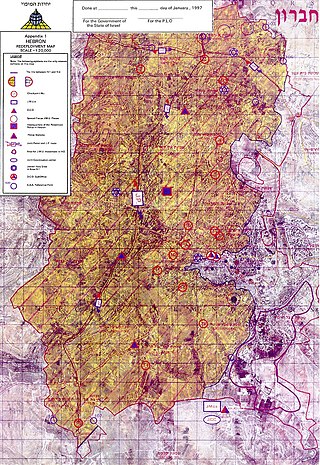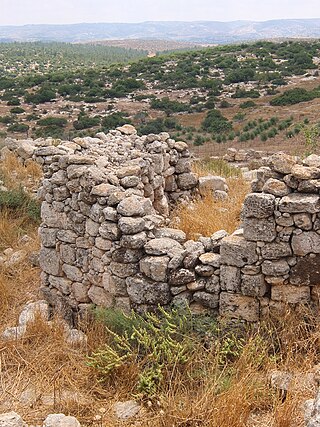
Hebron is a Palestinian city in the southern West Bank, 30 kilometres (19 mi) south of Jerusalem. Hebron is capital of the West Bank's largest governorate, known as Hebron Governorate. With a population of 201,063 in the city limits, the adjacent metropolitan area within the governorate is home to over 700,000 people. Hebron spans across an area of 74.102 square kilometres (28.611 sq mi). It is the third largest city in the country, followed by Gaza and Jerusalem. The city is often considered one of the four holy cities in Judaism as well as in Islam and Christianity.

Al-Qubayba, also known as Gbebah, Qubeiba or Qobebet Ibn 'Awwad, was a Palestinian village, located 24 kilometers northwest of Hebron.

Kiryat Arba or Qiryat Arba is an urban Israeli settlement on the outskirts of Hebron, in the southern Israeli-occupied West Bank. Founded in 1968, in 2022 it had a population of 7,490.

The Cave of the Patriarchs massacre, also known as the Ibrahimi Mosque massacre or the Hebron massacre, was a mass shooting carried out by Baruch Goldstein, an American-Israeli physician and extremist of the far-right ultra-Zionist Kach movement. On 25 February 1994, during the Jewish holiday of Purim, which had overlapped in that year with the Islamic holy month of Ramadan, Goldstein, dressed in Israeli army uniform, opened fire with an assault rifle on a large gathering of Palestinian Muslims praying in the Ibrahimi Mosque in Hebron. He killed 29 people, including children as young as 12, and wounded 125 others. Goldstein was overpowered and beaten to death by survivors.

There are six main administrative districts of Israel, known in Hebrew as mekhozot and in Arabic as mintaqah. There are also 15 subdistricts of Israel, known in Hebrew nafot and in Arabic as qadaa. Each subdistrict is further divided into natural regions, which in turn are further divided into council-level divisions: whether they might be cities, municipalities, or regional councils.

The Protocol Concerning the Redeployment in Hebron, also known as the Hebron Protocol or Hebron Agreement, was signed on 17 January 1997 by Israel, represented by Prime Minister of Israel Benjamin Netanyahu, and the Palestine Liberation Organization (PLO), represented by PLO Chairman Yasser Arafat, under the supervision of U.S. Secretary of State, Warren Christopher. It concerned the partial redeployment of Israeli military forces from Hebron in accordance with the 1995 Interim Agreement on the West Bank and the Gaza Strip. According to the Protocol, Area H-1 would come under Palestinian control, while Area H-2 would remain under Israeli control. A large Palestinian majority still lives in both Area H-1 and Area H-2. The redeployment started on 16 January 1997. The protocol has never been ratified by either of the contracting parties.
Burj, el-Burj, Al Burj, may refer to:

Bayt Jibrin or Beit Jibrin was an Arab village in the Hebron Subdistrict of British Mandatory Palestine, in what is today the State of Israel, which was depopulated during the 1948 Arab–Israeli War. It was preceded by the Iron Age Judahite city of Maresha, the later Hellenistic Marissa, located slightly south of Beit Jibrin's built-up area; and the Roman and Byzantine city of Beth Gabra, known from the Talmud as Beit Guvrin, renamed Eleutheropolis after 200 CE. After the 7th-century Arab conquest of the Levant, the Arabic name of Beit Jibrin was used for the first time, followed by the Crusaders' Bethgibelin, given to a Frankish colony established around a Hospitaller castle. After the Muslim reconquest the Arab village of Beit Jibrin was reestablished.

The districts and sub-districts of Mandatory Palestine formed the first and second levels of administrative division and existed through the whole era of Mandatory Palestine, namely from 1920 to 1948. The number and territorial extent of the districts varied over time, as did their subdivision into sub-districts.

The Gaza Subdistrict was one of the subdistricts of Mandatory Palestine. It was situated in the southern Mediterranean coastline of the British Mandate of Palestine. After the 1948 Arab-Israeli War, the district disintegrated, with Israel controlling the northern and eastern portions while Egypt held control of the southern and central parts – which became the Gaza Strip, under Egyptian military between 1948 and 1967, Israeli military rule between 1967 and 2005, part of the Palestinian National Authority after the Oslo Accords until 2007, and is currently ruled by the Hamas as a de facto separate entity from the Palestinian National Authority. The parts which Israel held since 1948 were merged into Israeli administrative districts, their connection with Gaza severed.

The Hebron massacre was the killing of sixty-seven or sixty-nine Jews on 24 August 1929 in Hebron, Mandatory Palestine. The event also left scores seriously wounded or maimed. Jewish homes were pillaged and synagogues were ransacked.

Barqusya was a Palestinian Arab village in the Hebron Subdistrict, depopulated in the 1948 Palestine War. It was located 31 km northwest of Hebron.

Dayr Nakhkhas was an Arab village located 20 km northwest of Hebron, overlooking Wadi Bayt Jibrin to the north.

Khirbat Umm Burj was a Palestinian Arab village in the Hebron Subdistrict, sometimes designated in modern maps as Burgin. Its ruins are today located within the borders of Israel. It occupied an extensive site, stretching about 30 dunams on the crest of a hill, rising some 430 metres (1,410 ft) above sea level, and commanding a good prospect of the surrounding region. It was depopulated during the 1948 Arab–Israeli War on October 28, 1948, during the third stage of Operation Yo'av under the command of Yigal Allon. The site is located 17 km northwest of Hebron.

Zayta was a Palestinian Arab village in the Hebron Subdistrict in Mandate Palestine. During Crusader rule in Palestine, the village is mentioned as forming part of the landholdings of the Order of St. John. At the time of the rule of the Ottoman Empire, according to the 1596 census, Zayta had a population of 165. Mentioned by Western travellers to the region in the 19th century, it is described by one as, "a picturesque Arab village"; by 1945, its population was 330 inhabitants.
The 2002 Hebron ambush took place in the Wadi an-Nasara neighborhood in Hebron in the West Bank on 15 November 2002. Israeli forces were subjected to a double attack by fighters from the Palestinian Islamic Jihad. The battle was referred to in Israel as "The attack on the worshippers' route" The place where the attack took place became known as the "Alley of Death" both in Hebrew and Arabic. The ambush was initially dubbed as the "Sabbath massacre" by official Israeli spokespersons.
Issa al-Hajj Suleiman Battat was a Palestinian Arab commander of rebels during the 1936–39 Arab revolt in Palestine based in the hills around Hebron. Battat was from the town of ad-Dhahiriya in the Hebron Subdistrict of the British Mandate of Palestine. He was a well-known commander in his home region and was suspected by the British authorities of involvement in the killing of British archaeologist J. L. Starkey in January 1938.
The Ashkelon Subdistrict is the northern of the two sub-districts in Israel's Southern District. Its population is more than half a million. It is an important region for manufacturing including electricity production and water desalination, agriculture, transportation, tourism, and trade.
The Beersheba Subdistrict is the southernmost subdistrict of Israel and one of two subdistricts in its Southern District. The capital of the subdistrict is, as the name implies, Beersheba. Rahat is the second-largest city and Eilat comes third. Other cities in the subdistrict are Arad, Dimona, Netivot, and Ofakim. Hura and Kseifa have not received city status yet are of similar size. The subdistrict includes an international airport, near Eilat, and a seaport in Eilat.















